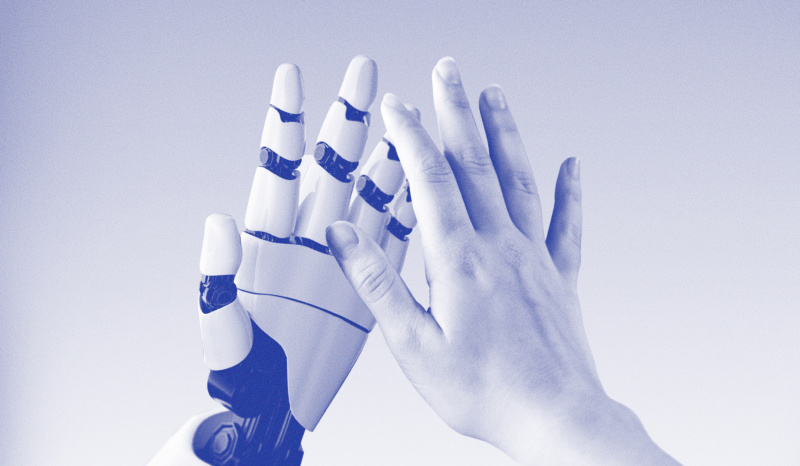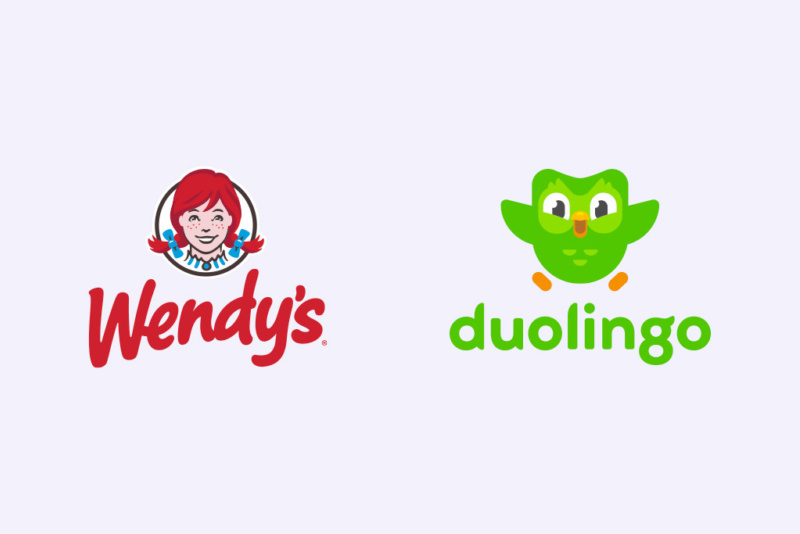Why empathy-driven content wins in the age of A.I.

A.I.-generated content is all the rage.
Brands and content creators are embracing it for fear they’ll get left behind. But with Large Language Modules (LLMs) trained off existing content, those who rely on A.I. alone risk losing their voice in a ‘sea of sameness’.
Yet you can still use innovative technology AND create content that’s genuine, resonant, and human at its core.
Let’s explore human-centric content and why emotionally intelligent storytelling is still one of a brand's strongest tools.
What if your brand were a person?
In writing, personification is when you give human characteristics to non-human things. It creates vivid imagery and helps the reader establish an emotional connection to your words.
It’s also common among marketers. Values. Personality. Purpose. These are human ways we define brands.
Consider Duolingo. At its core, Duolingo is a language-learning platform. But the brand is playful and doesn’t take itself too seriously. It even has a mascot, and though it’s an owl, it makes the brand appear more human.
Or how about Wendy’s. Fast food restaurants are a dime a dozen, with their products all being similar. However, as a brand, Wendy’s has differentiated itself by being sarcastic, cheeky, and a little combative on social media.
Point is, people connect with the Duolingos and Wendy’s of the world because they feel and sound like a human. Not a brand.
So, how can we apply the strategy of personification to creating content while streamlining processes using A.I.?

People-first content: Google approved
A.I.-generated content is flooding the internet. And Google cracking down, encouraging you to produce “helpful, reliable, people-first content.”
In its latest search essentials document, Google says to focus on people first, not search rankings. To do so, it recommends a self-assessment and offers a series of questions to ask yourself, including:
- Does the content provide original information, reporting, research, or analysis?
- Does the content provide insightful analysis or interesting information that is beyond the obvious?
- If the content draws on other sources, does it avoid simply copying or rewriting those sources, and instead provide substantial additional value and originality?
Note the language. Self-assessment. Beyond the obvious. Originality. It’s a reminder to insert yourself and your personal perspective into the process.
Now, Google doesn’t outright penalize A.I.-generated content, with Google Search Central stating, “Appropriate use of A.I. or automation is not against our guidelines.”
But content created to manipulate search rankings, low-quality content, and auto-generated content by A.I. alone does not perform as well as people-first content. In fact, based on Gotch SEO Academy’s own research, Google prioritizes original work with clear human input.
Remember, the point of content is to support your brand and your business goals. The best way to do that is to create it for humans, not bots.
Our ethical responsibilities as human beings
The price of community can often be inconvenience. When we want people to do things for us—personally or professionally—it’s a two-way street.
As a brand, if you want people to trust you, to choose you over others, to spend their hard-earned dollar on something you’re offering, you have to earn it. You owe it to your audience to put in the effort.
We also have ethical responsibilities to each other. Yes, it’s easier to ask ChatGPT to write an article for you. But can you be a brand that supports authenticity when you’re using inauthentic methods to try and connect with your audience?
Can you be an association that cares for members, while you support technology that eliminates jobs without proper support for the people being laid off?
Can you be an organization that promotes sustainability knowing A.I. uses 10x more energy than a standard Google search, and that the United Nations Environment Programme called the environmental impact of A.I. “concerning”?
The thing is, the answer to all of these questions might be “yes!” You may feel you do enough to connect, support, and authenticate outside of the content you’re putting forward. And if that’s the case, that’s awesome.
Still, we need to ask ourselves these questions and look at the big picture impact of A.I. usage before using it to run our organizations. Plus, staying human in how we work and create isn’t just an ethical stance. It’s how long-term brand loyalty is built.

Brand-building content > commodity content
A.I. was the focal point at the 2025 Cannes Lions International Festival of Creativity. (No surprise there.)
Marcus Wessen, Creative Director at Digital Domain, shared a common thread among the presentations and panels: "It's never been easier, faster and cheaper to create content... It's also never been easier, faster and cheaper to be mediocre."
Since generative A.I. is a regurgitation of what’s already been said, what it creates is average. Marketer and storyteller, Jay Acunzo, calls this commodity content in an issue of his newsletter from 2023.
Think of it this way, most people have ketchup in their fridge. Open a fridge full of A.I. content, and you’ll find the same metaphorical bottle of ketchup from brand to brand.
If we’re all reaching for the same bottle of ketchup, our fries all taste the same.
Content that builds your brand should be truly authentic. This means being raw and unfiltered, including personal anecdotes and first-party data, and sharing a POV unique to you and your brand.
Simply put, brand-building content resonates with your audience. It makes them say, “That’s exactly how I feel! This brand gets me.” Because it feels like it was written specifically for them by somebody just like them.
You can’t hack authenticity
Humans crave authenticity. Whether it’s in relationships, experiences, or yes, content. We want things that feel and sound real, written by someone who connects with us on a deeper level than SEO rankings and keyword research.
“When A.I.-generated copy is submitted to me, I feel the same as when my cat drops a dead mouse at my feet. I appreciate the spirit of the gesture. But ultimately, it’s lifeless and a bit yucky.”
Alison Butlin, Director of Strategy and Content at Art & Science
There’s something…off about A.I. content. It’s not real. It’s impersonal and some consumers even see it as a knock against a brand. These are some stats from a 2024 Bynder study on how consumers interact with A.I.-generated content vs human-made content:
- 26% of people feel a brand is impersonal if the copy does not feel human-written.
- 20% would feel that the brand is lazy if the copy was not human-written.
- 30% of people would think the associated brand is impersonal if they suspected they were chatting with an A.I. chat bot.
Alienating nearly one third of your audience—at minimum—is a good way to devalue your own efforts. More than 70% of consumers want to interact with brands that are authentic. Yes, there’s more to brand authenticity than your content. But if the way you’re communicating is not authentic, the rest of the experience with your brand needs to work twice as hard.
Plus, A.I. doesn’t just lack authenticity. It lacks emotion.
Decision making isn’t logical. It’s emotional.
What do you think about when making a decision?
We often weigh pros and cons, and while we’d love to believe the process is logical, that’s not the case. In fact, a 2023 study suggested that “in the absence of emotional markers, decision making is virtually unattainable.”
According to a 2024 study published in Brain Sciences, emotions play an even stronger role in decision making when the situation is characterized by ambiguity, uncertainty, and risk (sounds like the current world we’re living in, eh?)
We sometimes forget emotions aren’t just happiness and sadness. They’re fear, stress, guilt, envy, anticipation, excitement, optimism, rejection, threat, and even pride. They’re also a subconscious thing. As much as we try to manage our emotions through self-care, exercise, and mindfulness, the reality is we don’t control them.
This all comes back to reinvesting in face-to-face interactions with clients, members, and audiences. Why would we want a robot to tell us how someone is feeling when we can just ask them ourselves?
Let’s face it, the latter is faster and more efficient. And isn’t that the whole point?

So you saved some time. Now what?
We could all use time back in our day, right?
A.I. is ideal when your to-do list feels like a “one step forward, two steps back” situation.
- It can help get words on a blank page.
- It can provide some thought-starters for brainstorming.
- It can upscale or expand an image so it’s usable for larger-scale creative.
And it can even build a brand bot that knows the ins and outs of your style guide (psst…we can help you do that).
What A.I. can do for you is pretty evident, and it feels like the possibilities are endless. But the question is: now that you’ve saved five hours on a writing project by crafting the perfect prompt (if there is such a thing), how are you reinvesting that time back into your business?
Time is money, after all. Without reinvesting that time, you’re not making progress. You’re just eliminating critical thinking and devaluing your brand as a whole. Your brand needs attention, needs nurturing, needs human intervention.
Because with all that A.I. can do, what it can’t do is replace the human connection.
Why? It lacks empathy.
Cognitive empathy is understanding what others might be thinking or feeling, while emotional empathy lets us feel those emotions with them. Empathy is the link between humans that can’t be artificially replicated.
This means A.I. can’t build a personal relationship with clients that’s founded on years of collaboration, partnership, and conversation. It can’t sit in a room with members of your association and really listen as they share their concerns, frustrations, and ideas for the future. It can’t capitalize on an untapped need or niche that an audience might be itching for.
So if you’re integrating A.I. into your marketing plan, think about what you’ll do with the time and resources you’ve saved. This could be things like:
- Market and audience research: get to know your clients, members, and audiences better. What are they saying online? What are their user habits? What are their spending habits? What is it that’s motivating them day in and day out, and how can you use this information to deliver stronger value from your brand or organization?
- Stakeholder sessions: in so many of our stakeholder sessions with national associations, the theme of partnership keeps surfacing. Members want to be heard, they want face time with those who can help make a difference. They want active partnership with their association and to know it’s truly invested in helping them succeed.
- Attend more networking events: go meet people. It sounds simple but it’s an effective method in branding and building connections. People are more likely to remember Joe from Great Company™ who shared a laugh over a technical glitch than the Great Company™ sending a templated email with no name attached.
- Invest in strategy: operating without strategy is like baking without a recipe. Odds of success are slim, odds of disaster are mighty. Strategy isn’t just about content. It’s about business goals, how every single thing your company does moves the needle toward success. It’s a fluid, ever-changing mindset that requires in-depth analysis of where you want to go, when you want to get there, why you want to get there, and how you can make the journey count.
- Lean into experiential and activations: if you’re a B2C brand and you want to reinvest, look no further than experiential events. Did you know 85% of attendees have said they’re more likely to make a purchase after a branded event? In-person activations help with brand awareness, credibility, and building an emotional connection with a potential consumer.

Hi, human. How can we help?
At Alphabet®, we use A.I. to help improve efficiency, to do things that benefit clients (and ourselves!) through time saved, innovative creations, as the starting point for research, and much more.
We’re not using it to create content—okay, minus the odd internal image—or code websites or develop strategies. No, we’re leaving that work to the humans within the company. The ones we eat lunch with and ask about their weekends and perform at the 613 Agency Rock-off with.
Y’know. The ones that matter.
If you’re looking to create content with a people-first approach, or looking to strategically incorporate A.I. into the work you do, we can help. Reach out today and our humans will get in touch with your humans.




